Assessment of Nature-Related Dependences, Impacts, Risks, and Opportunities
As a leading telecommunications operator in Taiwan, Chunghwa Telecom (hereinafter the CHT) places immense importance on the stability of the natural environment. By following the TNFD (Taskforce on Nature-related Financial Disclosures) framework, we assess the impacts of our operations on nature and stakeholders, fostering harmonious coexistence between people and the nature.
- Introduction and Implementation of the LEAP Methodology
CHT adopted the LEAP methodology recommended by TNFD, taking into account Taiwan's natural conditions and data availability, to develop a localized "Locate and Evaluate" process aligned with local realities. The analysis focused on the overlap between operational sites and nature-sensitive areas, systematically assessing dependencies and impacts. In the Assess phase, TNFD categorizes nature-related risks into physical risks1 , transition risk2 , and systemic risks3 . The taskforce4 analyzed physical risks to operations, transition risks from regulations and trends, and explored opportunities arising from nature-related risk management, conducting a materiality analysis.
Material nature-related risks and opportunities5 were integrated into questionnaire design and distributed to major stakeholders and suppliers to gather feedback, which informed subsequent analyses. This process demonstrated CHT's commitment to stakeholder engagement and laid the foundation for refining nature-related issue management. Disclosures were made in accordance with TNFD's four recommended dimensions: Governance, Strategy, Risk & Impact Management, and Metrics & Targets.
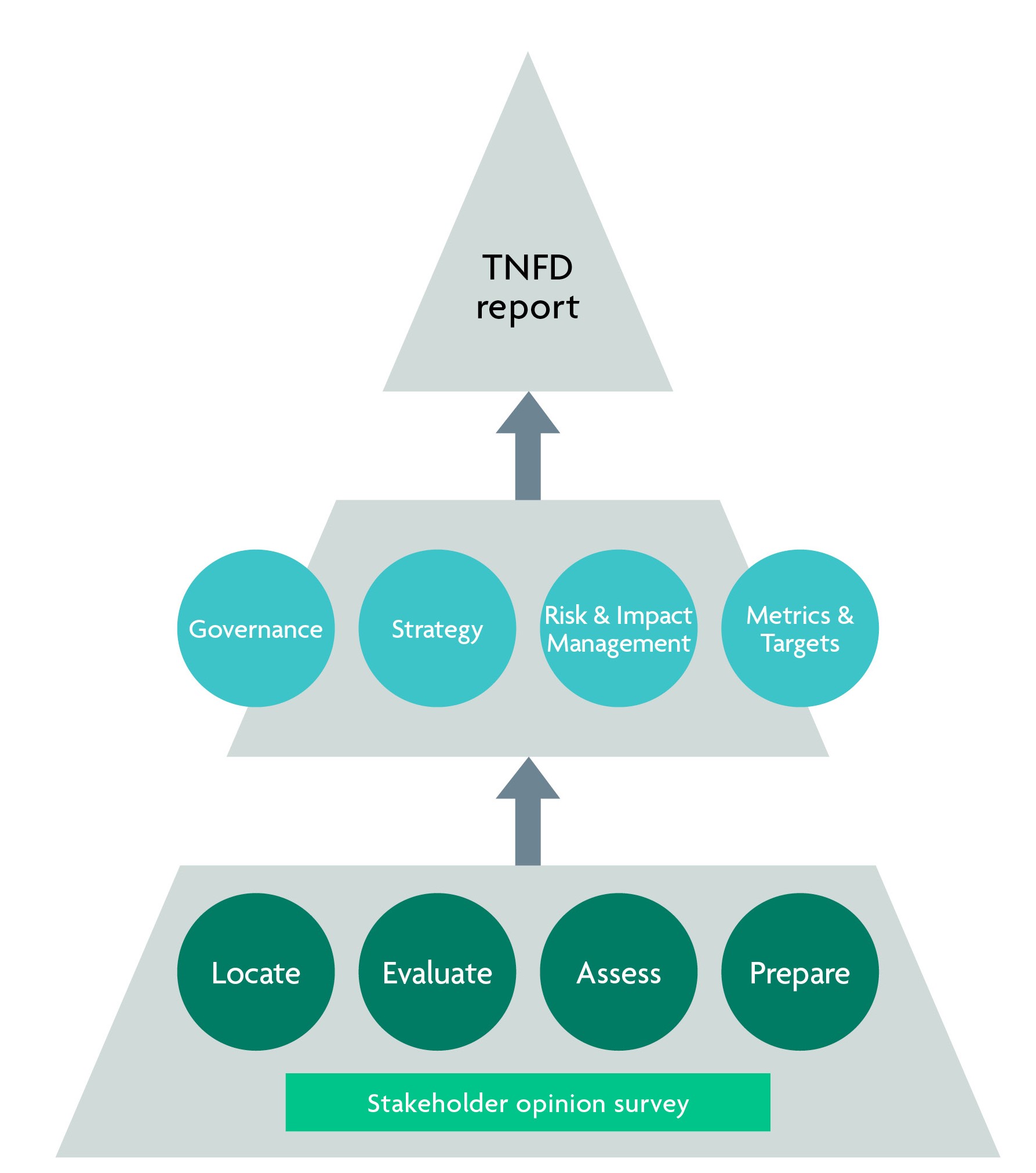
Chunghwa Telecom TNFD Implementation Roadmap
1.Risks posed to organizations by natural degradation, which are further categorized into acute risks: specific events having a strong impact or occurring in a short period that lead to changes in natural conditions, such as natural disasters causing changes in natural conditions; and chronic risks: long-term cumulative impacts that cause gradual changes to natural conditions, such as climate change causing changes in natural conditions.
2.Risks arising from the inconsistencies between management strategies and reduction of negative nature-related impacts, including policy and legal risks, market risks, technology risks, reputation risks, and liability risks.
3.Considering that nature-related systemic risks are relatively rare, they are not included in this analysis.
4.The taskforce for this report is a collaboration between CHT, the International Climate Development Institute (ICDI), the team led by a retired associate professor of National Taiwan University, and the Sustainable Transformation Service Team from Deloitte & Touche Risk Management Advisory Co., Ltd. (Hereinafter referred to as "the Taskforce").
5.Nature-related opportunities are categorized into business performance, such as markets, resource efficiency, products and services, capital flows and financing, and reputational capital; and sustainability performance, such as ecosystem protection, restoration and regeneration, and the sustainable use of natural resources.
Scope of Chunghwa Telecom's Biodiversity Assessment
CHT's business footprint and value chain can be categorized into three segments: upstream suppliers, direct operational activities, and downstream consumers. Upstream suppliers primarily consist of facility providers and engineering contractors. For its own operations, CHT's established sites include base stations, central offices, service centers and office buildings, pipeline facilities (cross-connect cabinets and telecommunication rooms), satellite stations, and submarine cables6
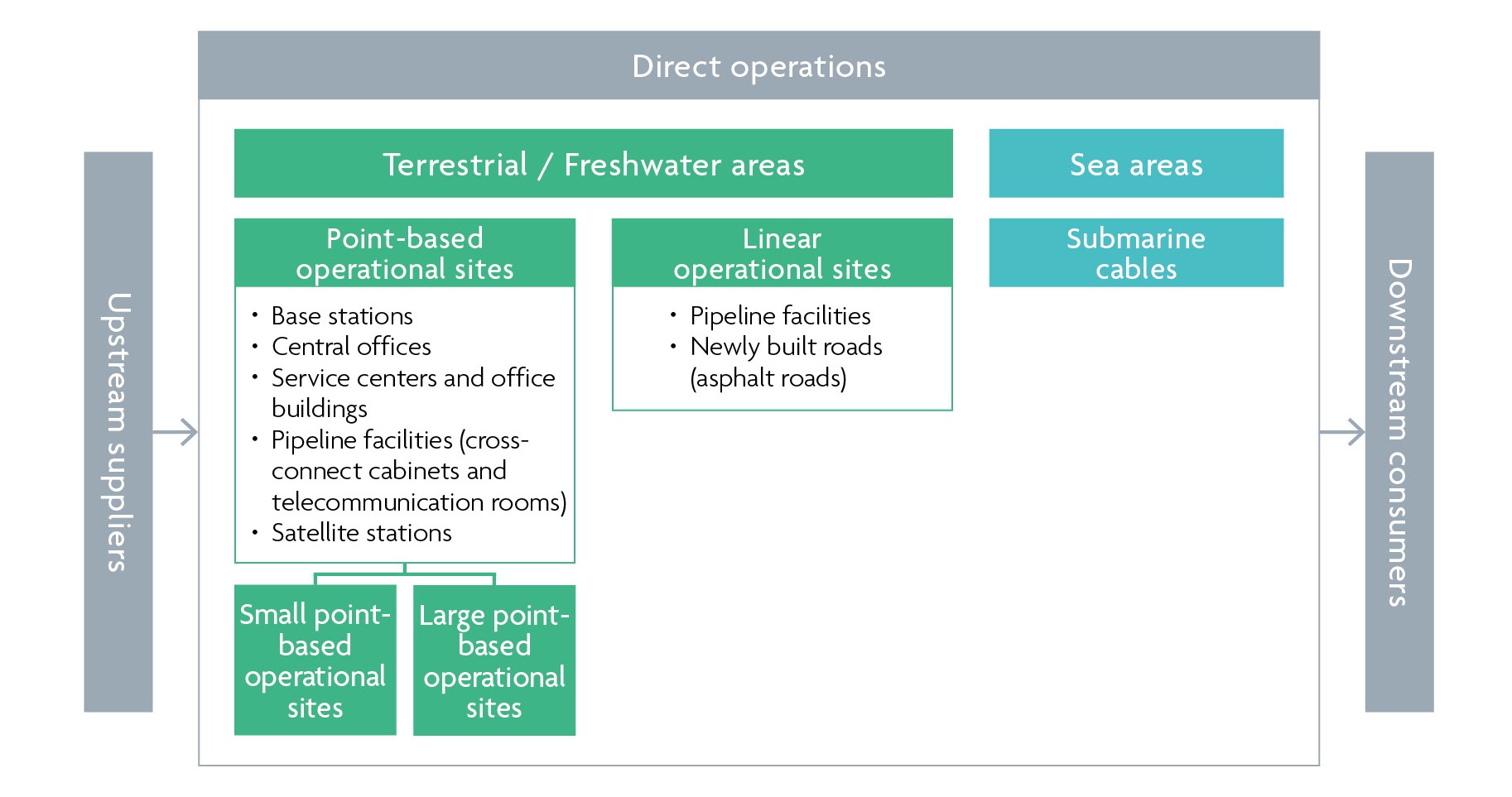
Chunghwa Telecom's Business Footprint and Value Chain
- Own Operations
- Suppliers
- Customers
Following last year's analysis scope of highly nature-sensitive base stations, this year's analysis scope for our own operational sites has been expanded to cover all land areas, including base stations, central offices, pipeline facilities (including cross-connect cabinets and telecommunication rooms), satellite stations, service centers, and office buildings.
In this year's supplier analysis, we focused on 186 key Tier 1 suppliers (accounting for 85.6% of the procurement amount), and evaluated their nature-related dependencies and impacts. Based on the types of contracts with key Tier 1 suppliers in 2024 and the nature of suppliers’ operational activities, the taskforce identified a total of 36 industries where the Tier 1 suppliers operate in line with ISIC.
When conducting LEAP analysis on its operations and value chain, CHT not only incorporates nature-related factors into the evaluation process but also organizes Nature-related stakeholders7 workshops. Through internal discussions, it identifies stakeholders involved in interactions with nature during operational activities (including customers), distributes questionnaires on nature-related risks and opportunities, and values their feedback.
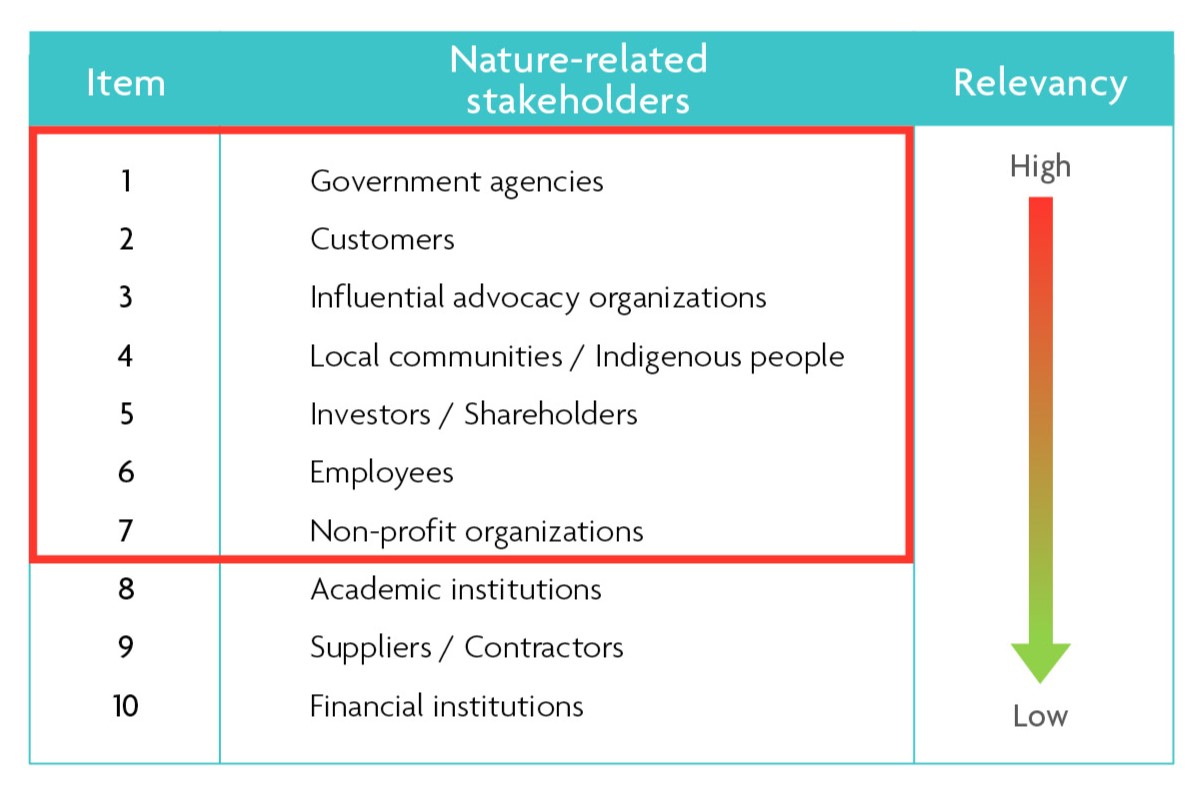
Identification Results for Major Stakeholders of CHT in 2024
6.Base stations serve as the central points for transmitting signals from mobile devices to telecommunication networks, enabling normal operations such as calls and data transmission. Central offices are facilities that house telecommunication service infrastructure, such as transmission systems, switching equipment, access networks, power supply systems, and air conditioning systems. These offices act as critical hubs for managing and distributing telecommunication services to ensure network reliability and efficiency. Data centers are large hubs for information and data storage, enabling enterprises to access and manage their data effectively. The service centers and office buildings primarily serve as locations for staff to work, receive clients, and provide services. The cross-connect cabinets and telecommunication rooms connect external telecommunication cables with the telecommunication equipment inside the buildings.
7.Based on criteria such as the closeness, significance, and degree of impact on nature-related stakeholders, CHT has selected the top two-thirds, resulting in seven categories of nature-related stakeholders identified as the Company’s major nature-related stakeholders.
TNFD LEAP Analysis Methodology
➤ Locate : Locating nature-sensitive operational sites
- Own Operations
- Suppliers
According to the LEAP methodology recommended by TNFD, the Company first completed the "Locate" step through localized analysis, confirming the business footprint and value chain, and initially identifying dependencies and impacts on nature. Based on the criteria of Natural Sensitivity and Operational Impact, we assessed the ecological environment near operational sites, identified sensitive locations, and prioritized them for the subsequent Evaluate analysis.
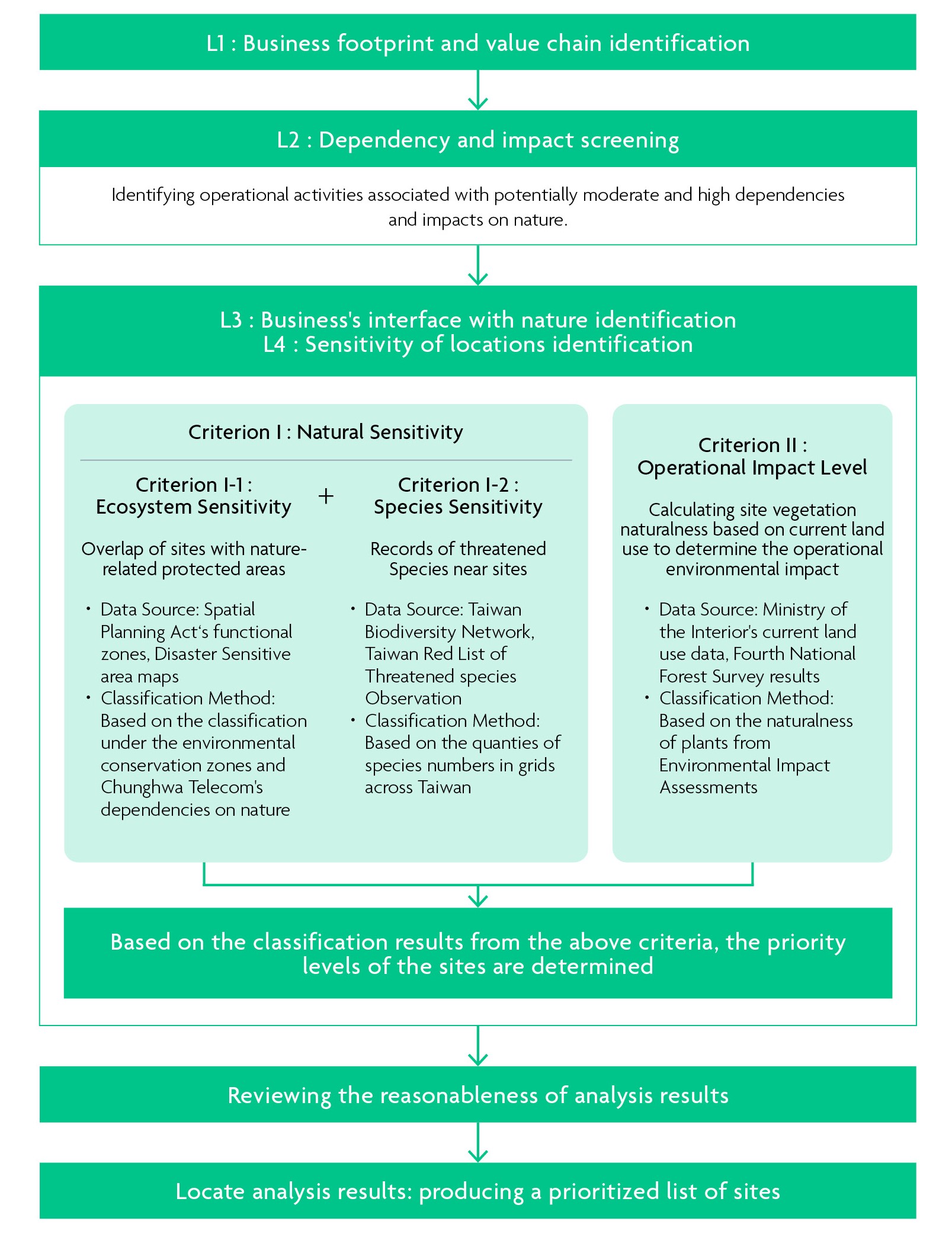
The Localized Locate Analysis Process
Regarding the types of sites operated by CHT as identified within its business footprint, to identify those that may have a moderate to high dependency and impact on nature, the taskforce referenced the ENCORE database, and initially screened the dependencies and impacts that CHT's operational sites and key Tier 1 suppliers have on nature, using general global assessment metrics and considering Taiwan's natural conditions. The analysis of nature dependencies and impacts is as follows.
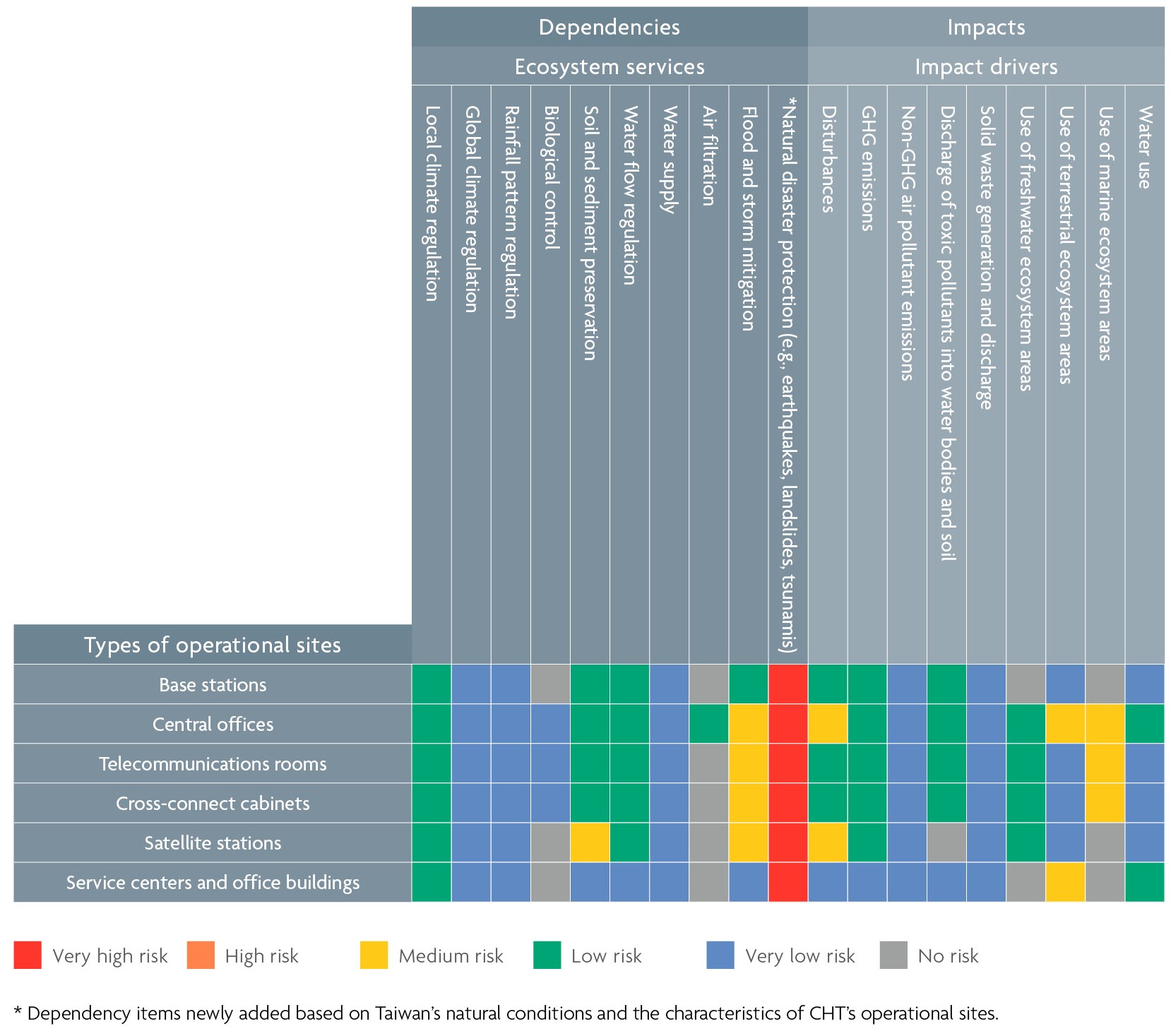
Dependencies and Impacts on Nature by Type of Chunghwa Telecom's Operational Sites
Compared with other types of operational sites, CHT's base stations are more widely distributed, with more than 20,000 locations across Taiwan , many of which are located in ecological preservation areas. To comprehensively review the interaction between Chunghwa Telecom's operations and nature and to facilitate the promotion of subsequent natural risk management measures, the scope and number of sites analyzed have significantly expanded compared to 2023. This year's analysis includes not only base stations but also central offices, satellite stations, telecommunication rooms, cross-connect cabinets, service centers, and office buildings.
The identification of operational site sensitivity is conducted in two stages. The first stage involves screening sites located within or near biodiversity-related environmentally sensitive areas8 , as defined in the “Environmental Impact Assessment Operating Guidelines for Development Activities,” prioritizing them for evaluation. In the second stage, the taskforce applies two localization criteria to assess site sensitivity and determine the evaluation priority.
The two localization criteria are :
| Natural Sensitivity | Includes Ecosystem Sensitivity (overlap between sites and natural preservation areas) and Species Sensitivity (number of threatened species on the Red List near the sites). |
| Operational Impact: | Assesses the naturalness of sites based on current land use conditions to evaluate the potential environmental impact of site establishment and operation. |
Compared to 2023, the scope and number of analyzed locations have significantly expanded this year, demonstrating Chunghwa Telecom's enhanced comprehensiveness in operational site management and risk control. The analysis results show that first-priority sites account for approximately 0% to 1.5% of all locations. Since satellite stations, telecommunications rooms, service centers, and office buildings are all located in areas of human activity, none of these sites fall under the first-priority classification.
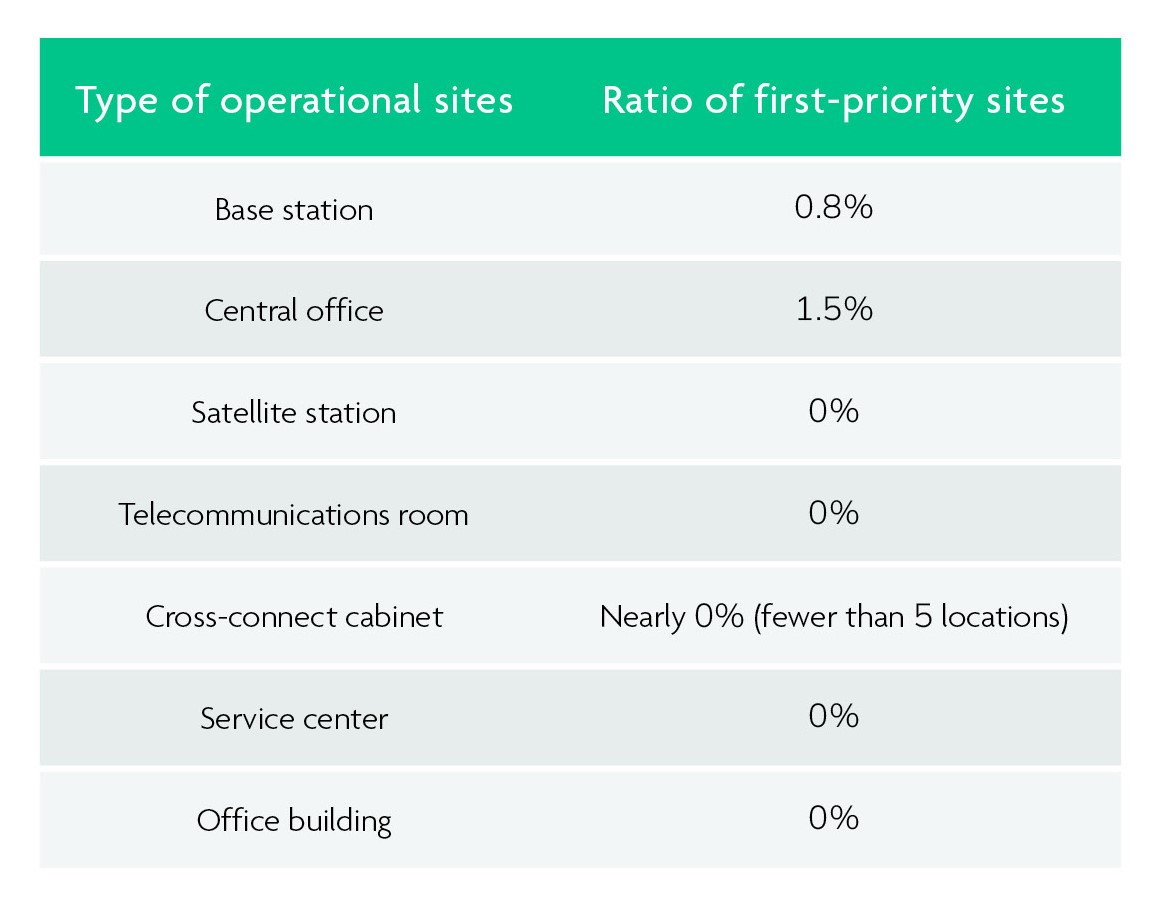
Locate Analysis Types and Results for Our Operations
Given the critical role suppliers play in the Company's operations, this year, we expanded the analysis scope to the value chain, to more comprehensively identify nature-related risks and opportunities. Referencing TNFD-recommended analysis steps, we conducted the localized Locate analysis. The taskforce screened Tier 1 suppliers, identified industries via International Standard Industrial Classification (ISIC), and used the ENCORE9 database to assess ecosystem dependencies and impacts, forming a dependency and impact matrix. We prioritized industries with high dependencies, impacts, and contract values. For companies with medium to high contract values in these industries, location data was collected to assess site sensitivity for further Evaluate analysis.
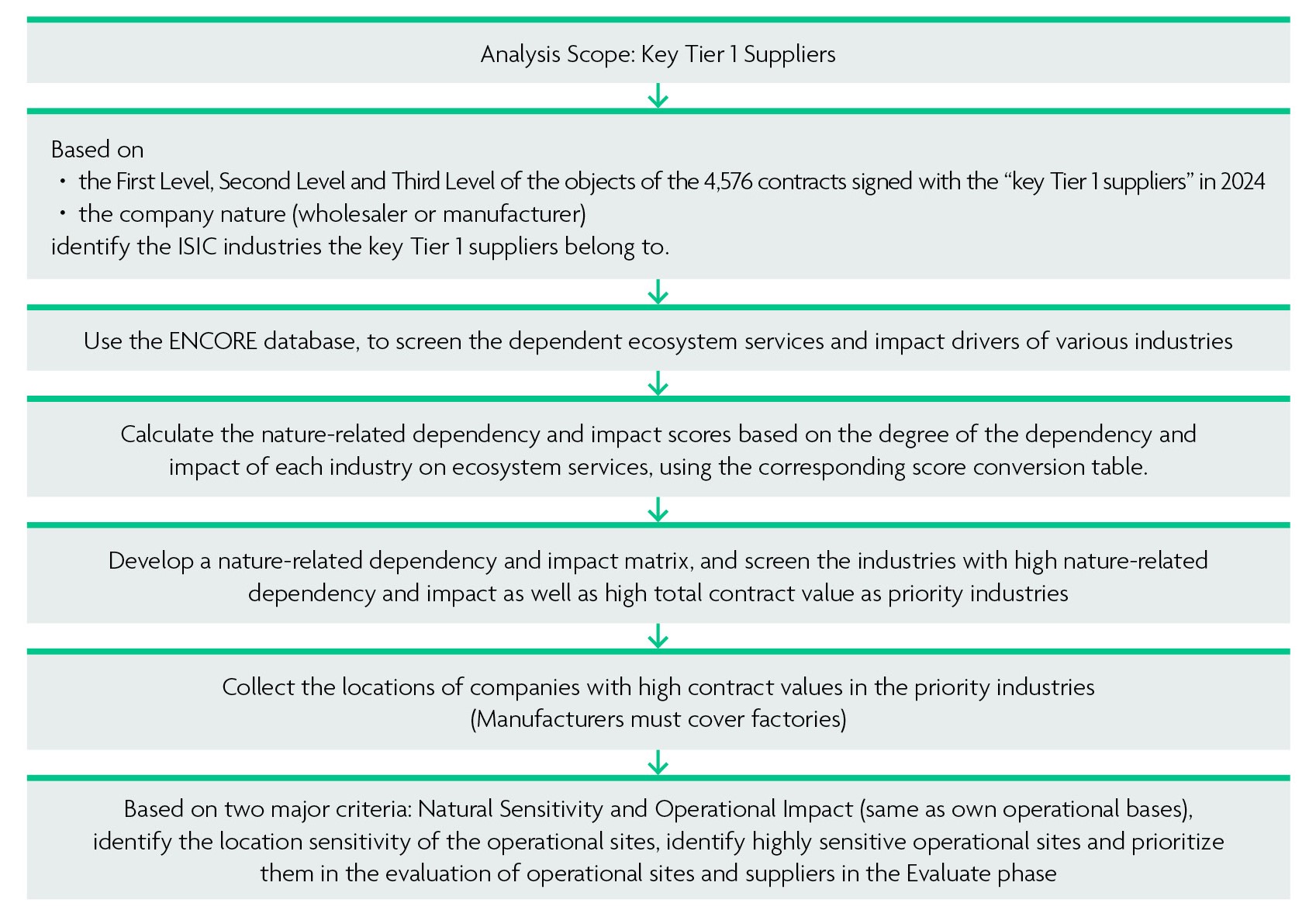
Supplier Localization Analysis Process
The taskforce used the ENCORE database to screen the ecosystem services and impact drivers that each industry relies on. The degree of dependency and impact of each industry was then converted into scores to establish a matrix of supplier dependency and impact for each industry.
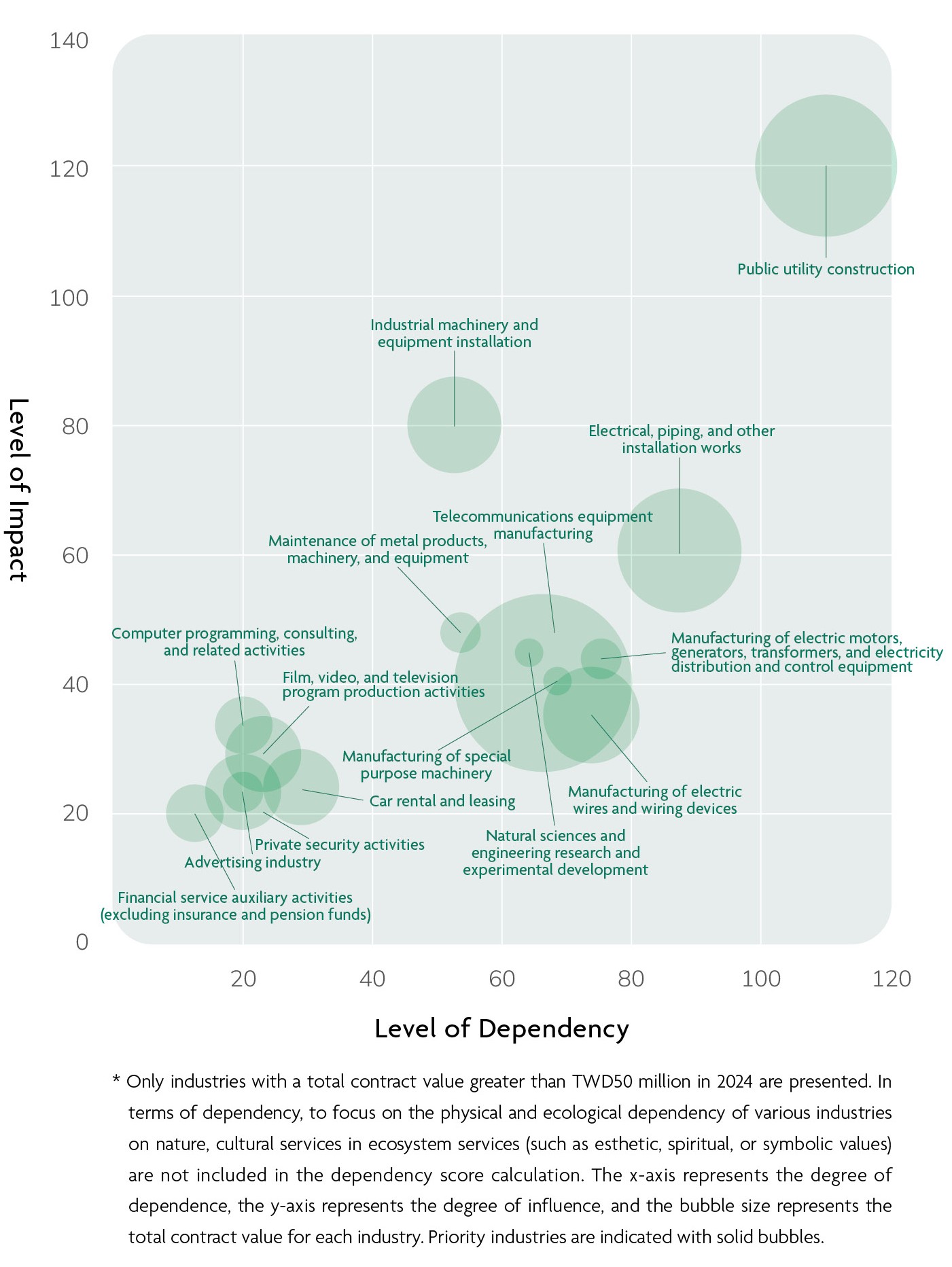
Matrix of supplier dependency and impact by industry
Through the matrix of supplier dependency and impact across various industries, the industries with high dependency and impact on nature, and high total contract values, were selected as priority categories. This year, four priority industries were selected: public utility construction, electrical pipeline and other installation works, industrial machinery and equipment installation, and communication equipment manufacturing. The analysis of nature dependencies and impacts is as follows.
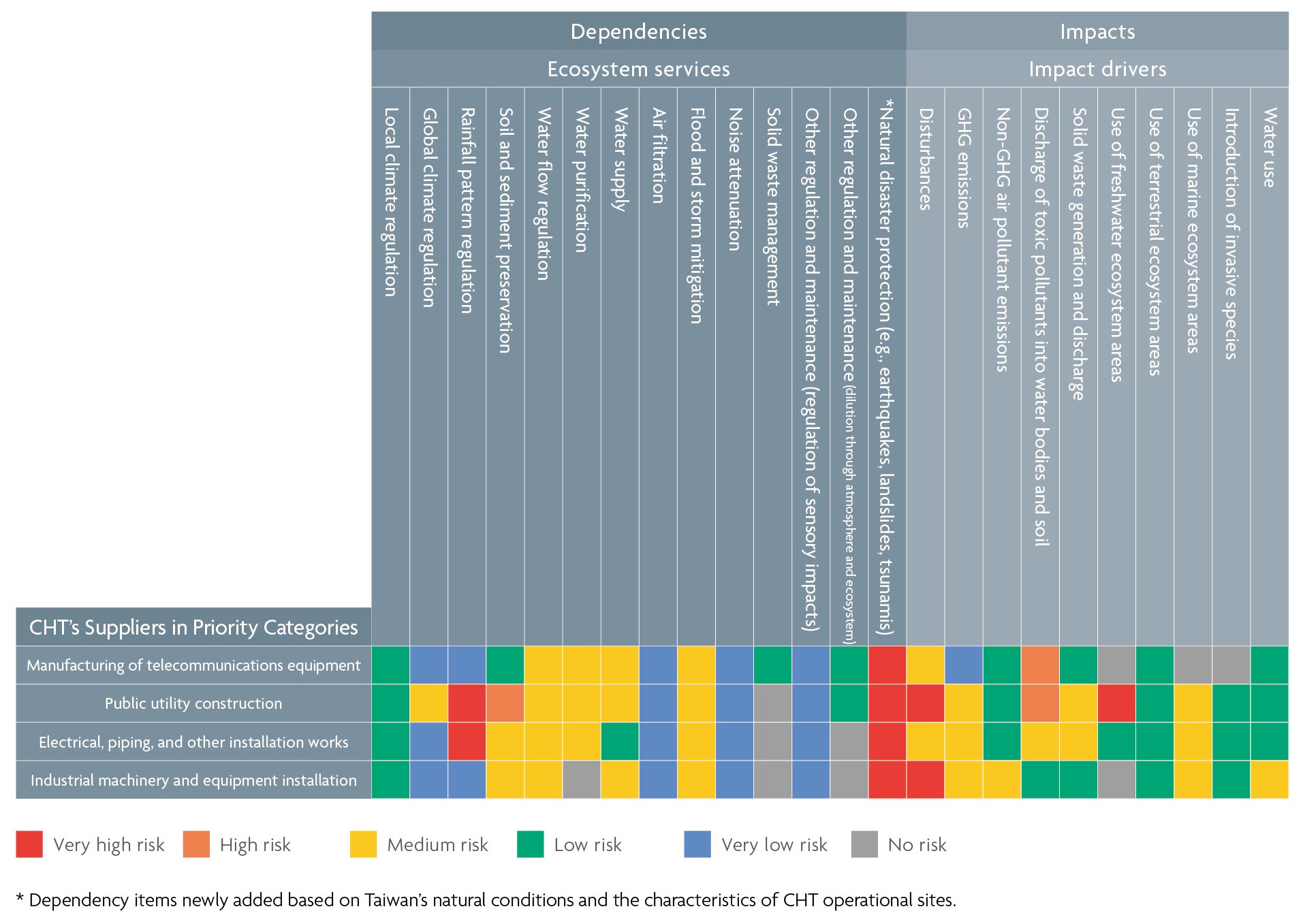
Dependencies and Impacts of Priority Industry Suppliers
From 4 priority categories, 65 suppliers with high contract values were selected, covering 68 operational sites in Taiwan (62 business addresses and 6 factory addresses). Using Criterion I (Natural Sensitivity) and Criterion II (Operational Impact), the sensitivity of these sites was assessed, revealing no sites within the priority scope.
8.Biodiversity-related environmentally sensitive areas include nature reserves, natural conservation areas, wildlife protection areas, important wildlife habitats, reservoir storage areas, water quality protection areas, Taiwan Coastal Area Nature Conservation Plan (I), Taiwan Coastal Area Nature Conservation Plan (II), internationally important wetlands, nationally important wetlands, state forest enterprise zones, national parks, national nature parks, reservoir catchment areas, secondary coastal protection zones, aquatic life propagation and conservation areas, artificial reef areas, and protected reef areas.
9.Exploring Natural Capital Opportunities, Risks and Exposure is a natural assessment database jointly developed by the United Nations Environment Program World Conservation Monitoring Center (UNEP-WCMC) and the Natural Capital Finance Alliance (NCFA).
➤ Evaluate : Analysis of Nature-Related Dependencies and Impacts
Based on the nature-related dependencies and impacts identified in the Locate phase, Chunghwa Telecom reviewed the interdependencies between various site types (base stations, center offices, cross-connect cabinets and telecommunication rooms, satellite stations, service centers, and office buildings) and nature across their lifecycle, from site selection, planning and design, construction, and operation to decommissioning. This process identified the dependencies and impacts of CHT's actual operations on nature.
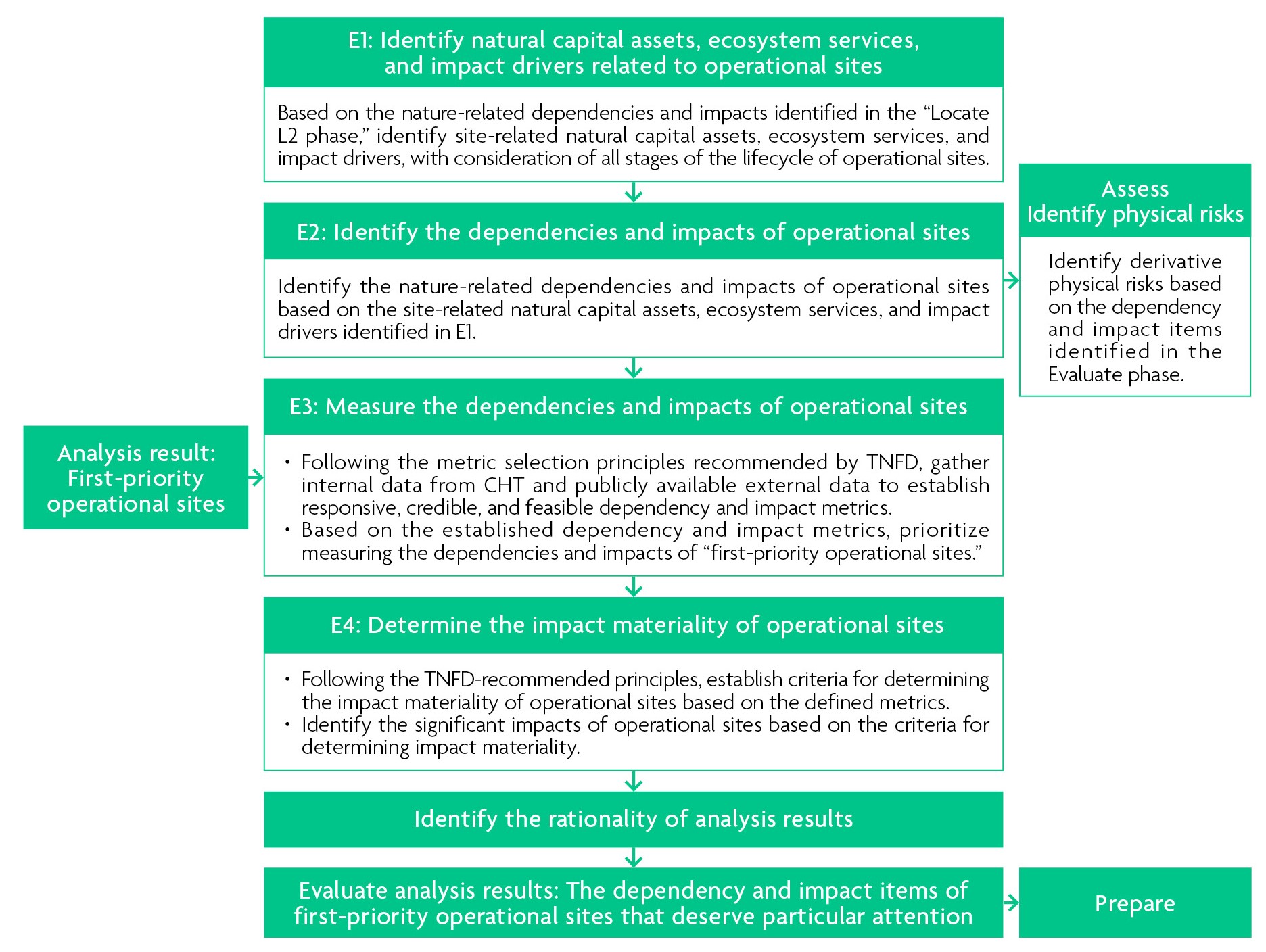
Evaluate: the Localization Analysis Process and Its Linkages with Other Stages
- Own Operations
- Suppliers
ased on the natural dependencies and impacts identified during the Locate phase using the ENCORE tool, and taking into account Taiwan's local natural conditions, Chunghwa Telecom has evaluated the environmental dependencies of various types of sites under normal operations, as well as the potential impacts on nature across different stages of the lifecycle (e.g., site selection, design, construction, operation, and decommissioning), as detailed in the table “Items of Dependencies and Impacts for Different Site Types”.
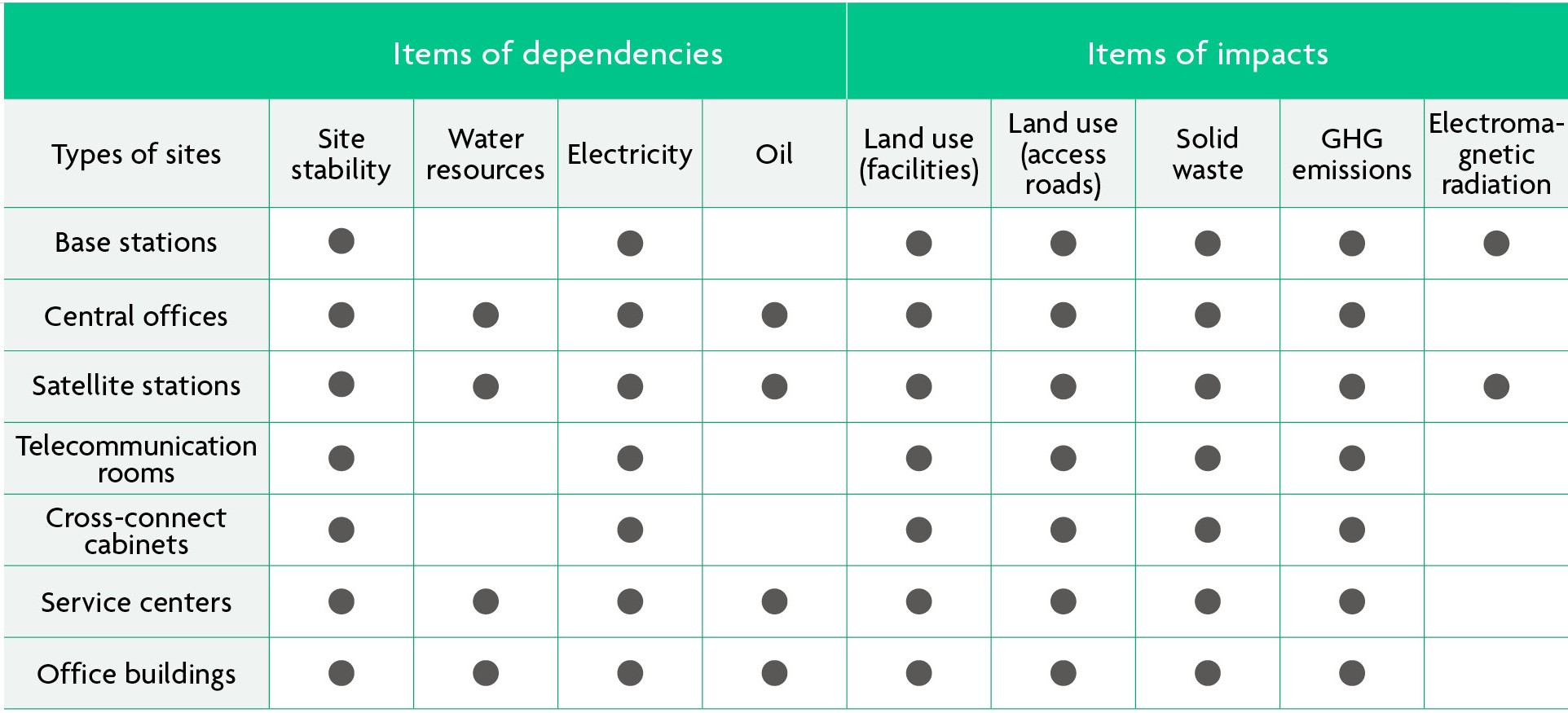
Items of Dependencies and Impacts for Different Site Types
According to the ecosystem services relied upon by the various site types of Chunghwa Telecom during normal operations, as detailed in the table "Corresponding Ecosystem Services for Each Dependency Item".
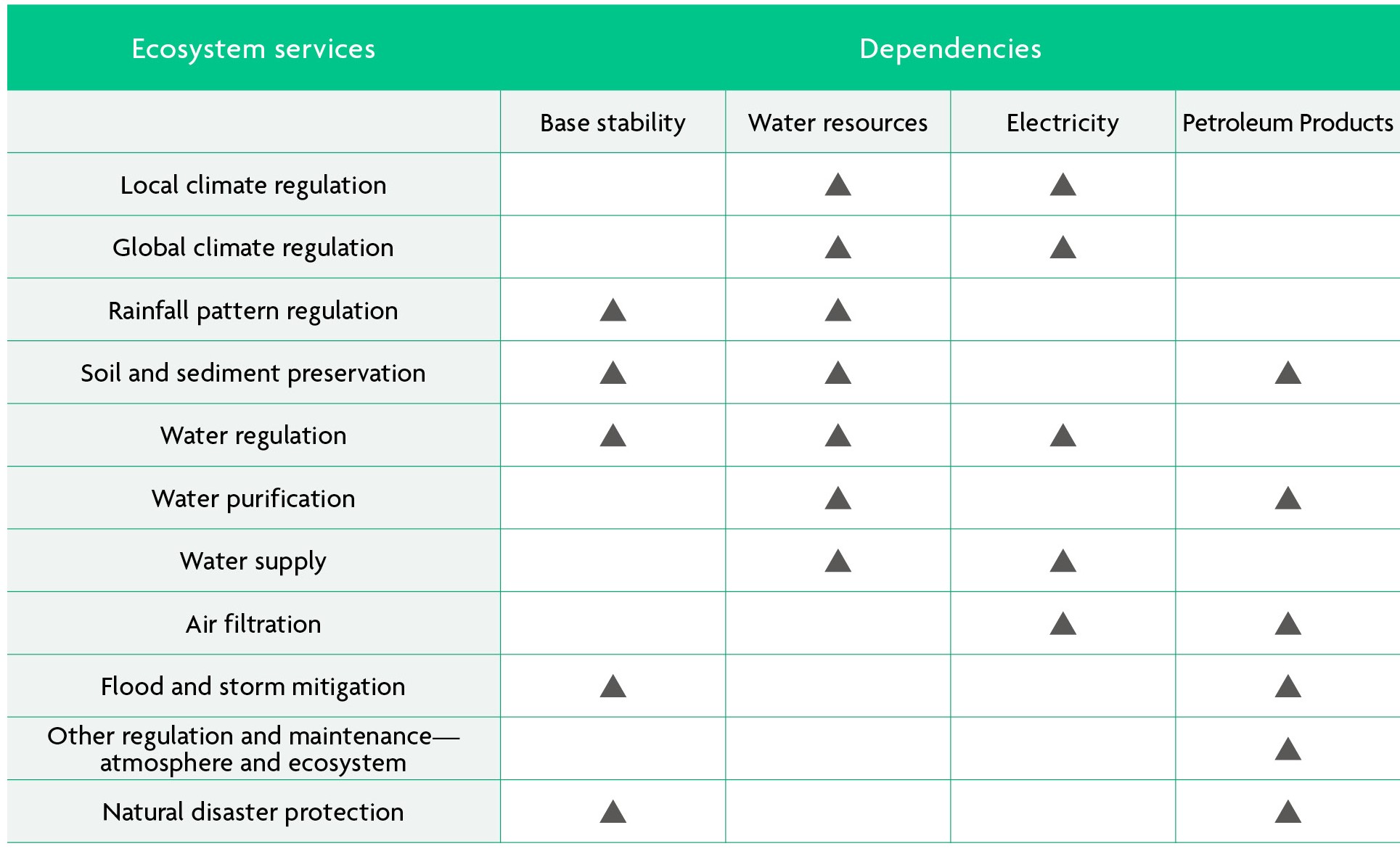
Corresponding Ecosystem Services for Each Dependency Item
Based on the dependency and impact items of each type of operational sites identified in the previous phase, the taskforce referenced the TNFD-recommended indicator selection criteria to conduct practical discussions. Through collecting internal data from CHT and external public data, responsive, credible, and feasible dependency and impact metrics were developed. The metrics for each dependency and impact item are shown below.
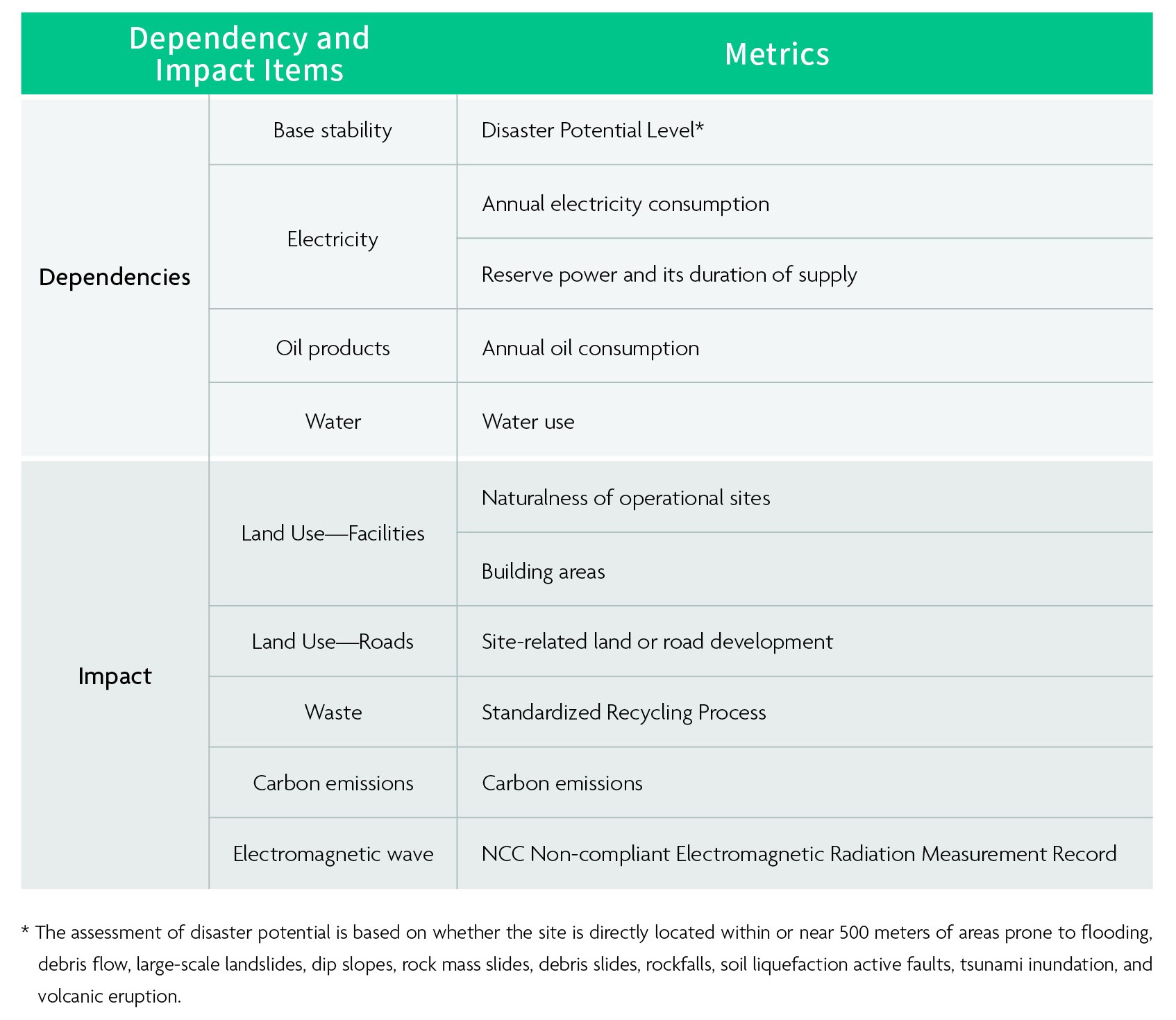
Dependency and Impact Measurement Indicators
In the Evaluate phase, the focus is on priority industries. Based on the results of the Locate phase, further analysis is conducted on their dependence on and impact on nature. By consolidating contract contents of high-contract-value suppliers, operational activities related to the Company are summarized, and relevant dependency and impact items are identified with reference to their operational characteristics at various stages of the lifecycle.
| Key Industries of Focus | Industry Description |
|---|---|
| 1.Public Works Construction | In the field of public utility construction, the Company's related operational activities include cable laying, civil engineering, relocation and renovation works. |
| 2.Installation of electrical conduits and others | These operational activities include the installation of user equipment, mobile communication equipment, transmission equipment, and information equipment. |
| 3.Installation of industrial machinery and equipment | The Company's related operational activities include the installation of exchange equipment, power, and air-conditioning equipment. |
| 4.Manufacturing of communication equipment | The Company's supply chain operations related to equipment manufacturing include manufacturing of switching equipment, mobile communication equipment, and transmission equipment. |
The analysis results regarding the dependencies and impacts on nature by the priority industries will serve as a reference for the Company in promoting supply chain risk management and sustainable procurement policies. For further details, please refer to the TNFD (Taskforce on Nature-related Financial Disclosures) reports for comprehensive insights.
➤ Assess : Nature-related risks and opportunities assessment
Chunghwa Telecom summarized and identified nature-related risks and opportunities in four steps, based on its actual operating conditions.
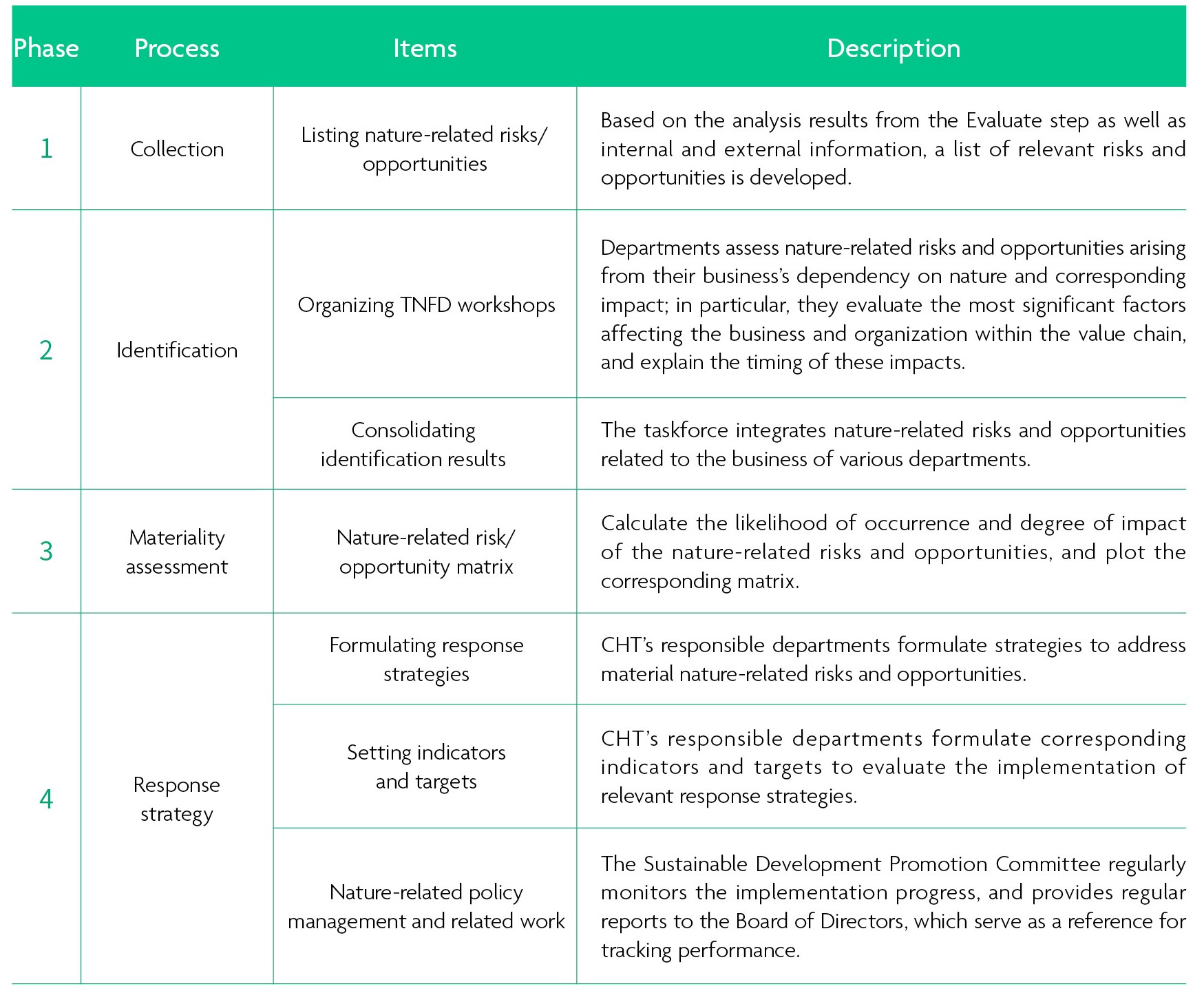
Nature-related Risks and Opportunities Identification Process
- Identification of Material Nature-Related Risks
- Identification of Material Nature-Related Opportunities
- Entrance into emerging markets
- Protection/conservation/sustainable management of threatened species
- Collaborate with stakeholders to improve the ecological environment
The taskforce identified 9 issues related to physical and transition risks, leading to the creation of a Nature-Related Risks Matrix. Ultimately, 1 high-likelihood physical risk and 3 transition risks were prioritized for management. The relevant results are as follows.
| Nature-related risks Type | Value Chain Scope | Natural Risk Factors |
|---|---|---|
| Physical risks | Own Operations | Occurrence of natural disasters |
| Transition risks | Own Operations | Stricter natural disclosure and environmental assessment regulations |
| Suppliers | Demand for high-efficiency, low-impact technological transformation | |
| Customer | Preference shifting towards nature-friendly products or services |
After identifying 4 nature-related risks, we distributed online and physical questionnaires to major natured-related stakeholders and key Tier 1 suppliers to understand the extent of their connection to these risks and expectations, helping the company better incorporate relevant perspectives into its risk management strategies.
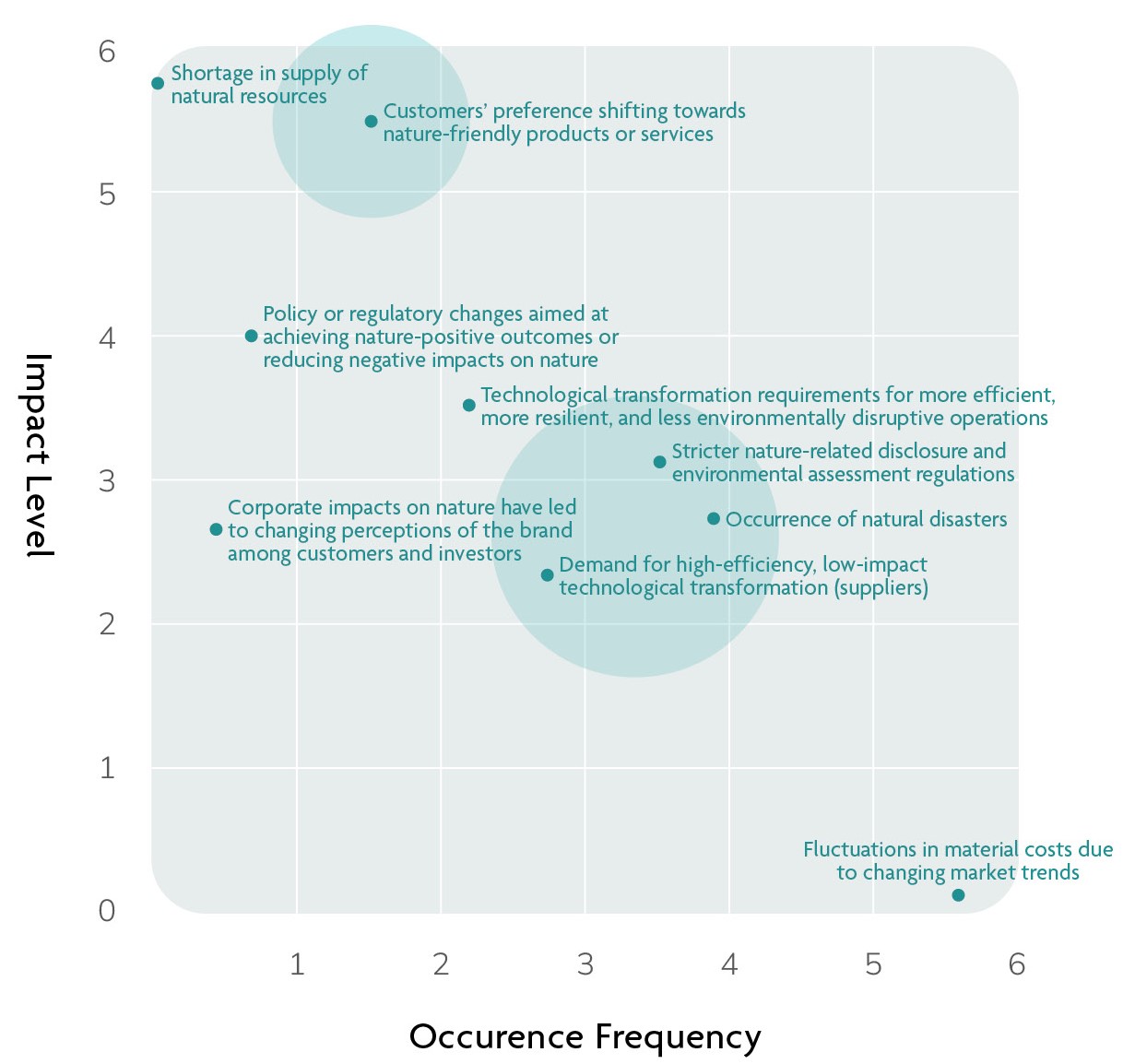
CHT's Nature-Related Risks Matrix
To identify Chunghwa Telecom's material nature-related opportunities, the taskforce collected 13 issues related to business and sustainability performance, creating a Nature-Related Opportunities Matrix. It prioritized one business issue and two sustainability issues with high frequency and significant impact for management. The relevant results are as follows.
| Nature-related Opportunity Type | Value Chain Scope | Natural Opportunity Factors |
|---|---|---|
| business performance issue | Own Operations |
|
| sustainability performance issue | Own Operations |
|
After identifying three material nature-related opportunities, we also distributed online and physical questionnaires to major nature-related stakeholders and key Tier 1 suppliers.
Supported by questionnaire data, CHT's strategies for natural mitigation, adaptation, and protection will manage its nature-related risks while creating more opportunities to collaborate with major nature-related stakeholders for win-win outcomes.
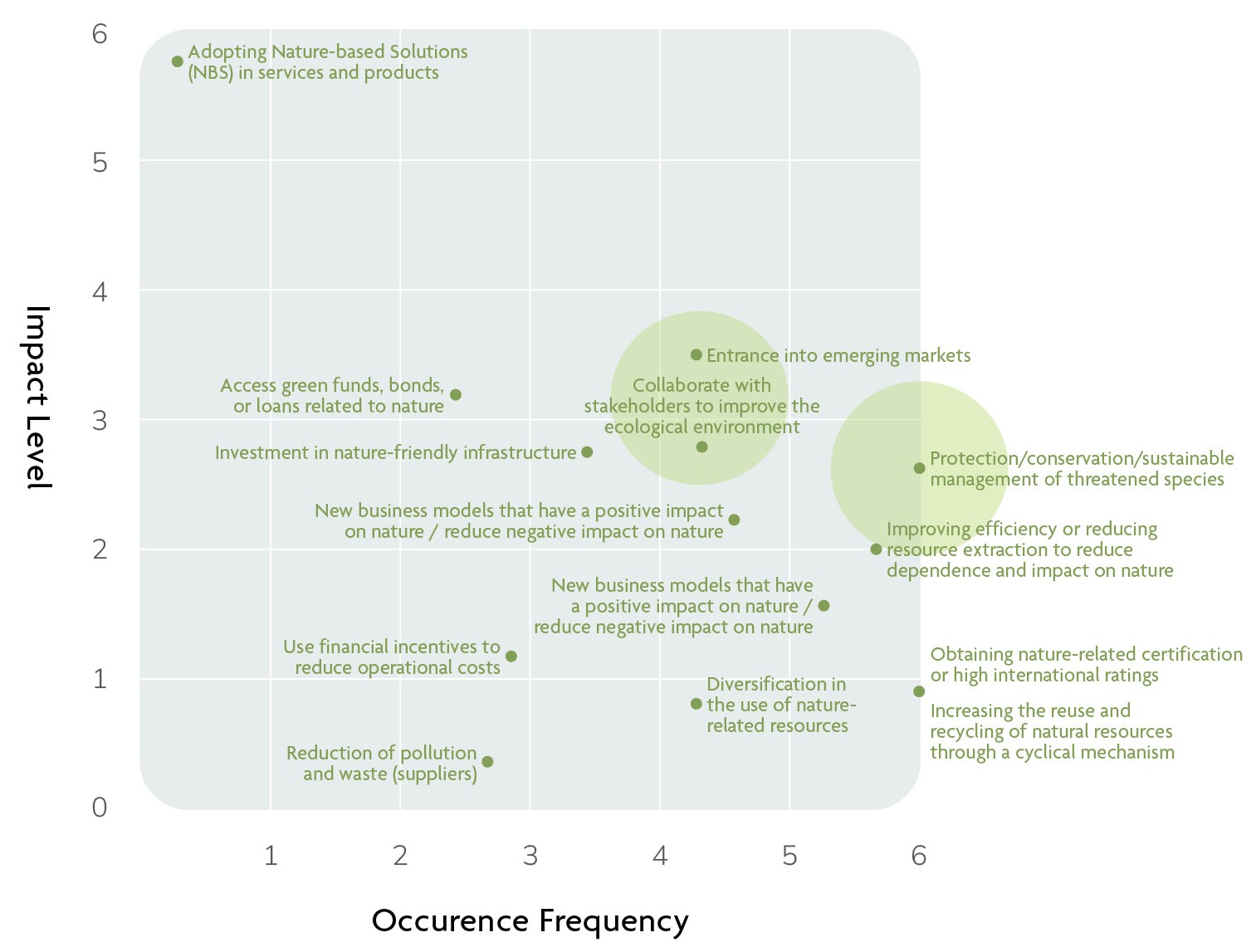
CHT's Nature-Related Opportunities Matrix
➤ Prepare: Proposeing nature-related response strategies and targets
Based on the results of the Assess phase, to actively mitigate the impact of nature-related risks, seize nature-related opportunities, and enhance competitive advantages, the taskforce, in collaboration with various business units, evaluated the impacts of risks and opportunities arising from nature-related dependencies and influences on the Company's business model, and formulated corresponding response strategies. For detailed explanations of the response strategies for material nature-related risks and opportunities, please refer to Section “III (II) Response Strategies for Nature-Related Risks and Opportunities” in the TNFD Report.
CHT's long-term biodiversity conservation pathway commitment encompasses "mitigating nature loss" and "promoting nature positivity." The details of the goals and indicators are as follows. In the future, Chunghwa Telecom will continue to review the implementation of various actions, to ensure the effective execution of action plans, demonstrating the company's strong emphasis on and commitment to natural capital, and gradually realizing a long-term conservation vision.
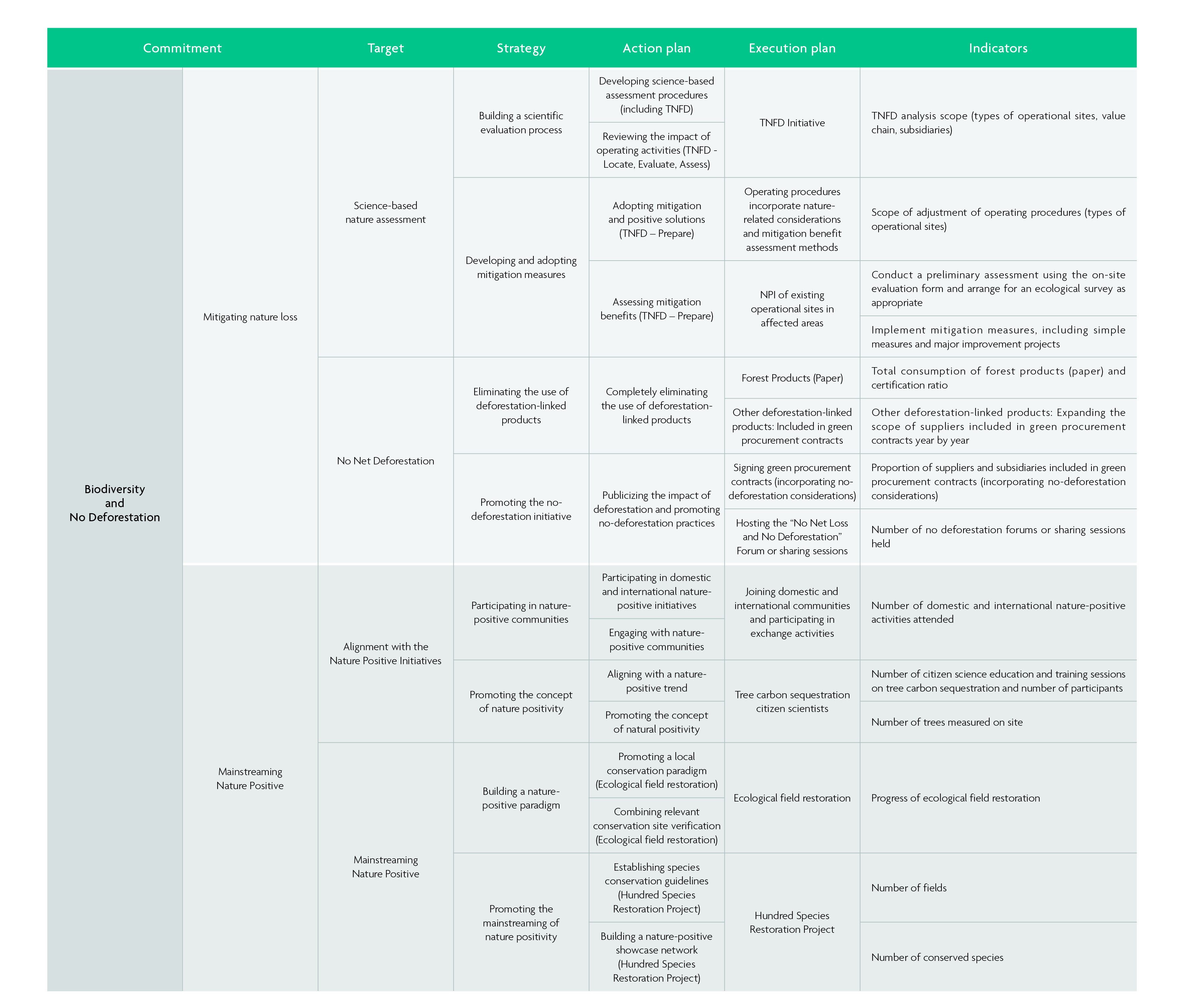
Long-term Conservation Pathway Indicators
Natural Risk and Impact Management
Chunghwa Telecom faces challenges from market competition, technological changes, regulatory shifts, ecological impacts, and climate change. To ensure sustainable operations and long-term development, CHT established a functional committee under the Board of Directors, the "Risk Management Committee", as the highest decision-making and supervisory body for risk management under the Board of Directors. Additionally, an executive-level committee, the "Risk Management Steering Committee", has been set up to coordinate and implement risk management activities across the entire company..
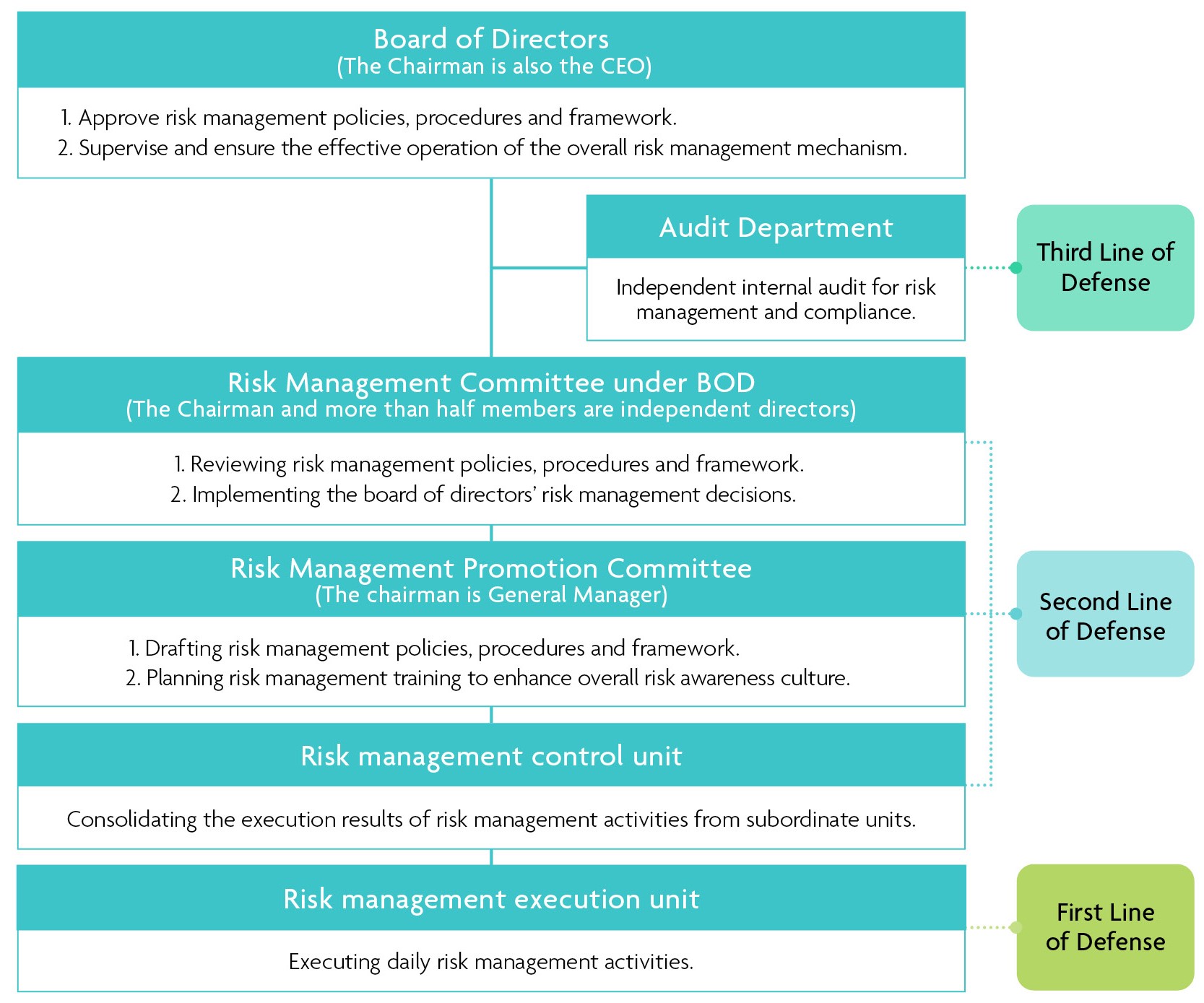
CHT Risk Management Organization Structure
CHT is committed to the vision of "living in harmony with nature" and to creating long-term sustainable value for the Company and its stakeholders. By using the LEAP methodology recommended by TNFD, CHT analyzes nature dependencies and impacts across its operations, activities, and the value chain to identify nature-related risks and opportunities. These risks are integrated into the Enterprise Risk Management (ERM) system to ensure effective control, uninterrupted operations, and stakeholder interests.
To promote awareness of nature-related risks, CHT conducts regular environmental education and sustainability training. These programs enhance employees’ understanding of the interdependance between business operations and the natural environment, stay informed on global sustainability trends, and foster a culture of environmental sustainability.
For more information on strategies to address nature-related risks and opportunities, please refer to the 2024 TNFD Report.
Documents
-
 Chunghwa Telecom's Report for Taskforce on Nature-related Financial Disclosures (TNFD) , 2024 Edition.
Chunghwa Telecom's Report for Taskforce on Nature-related Financial Disclosures (TNFD) , 2024 Edition.


